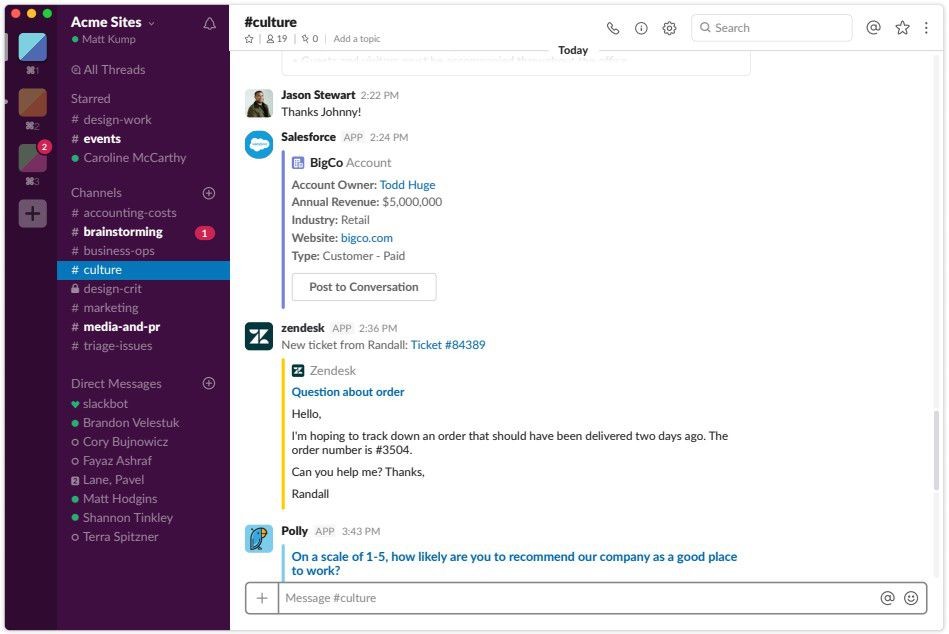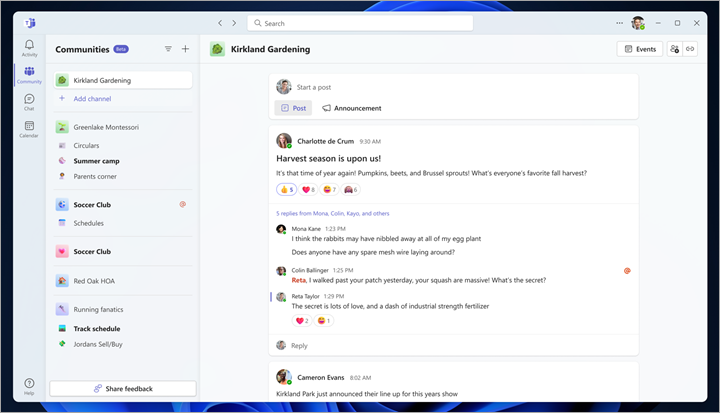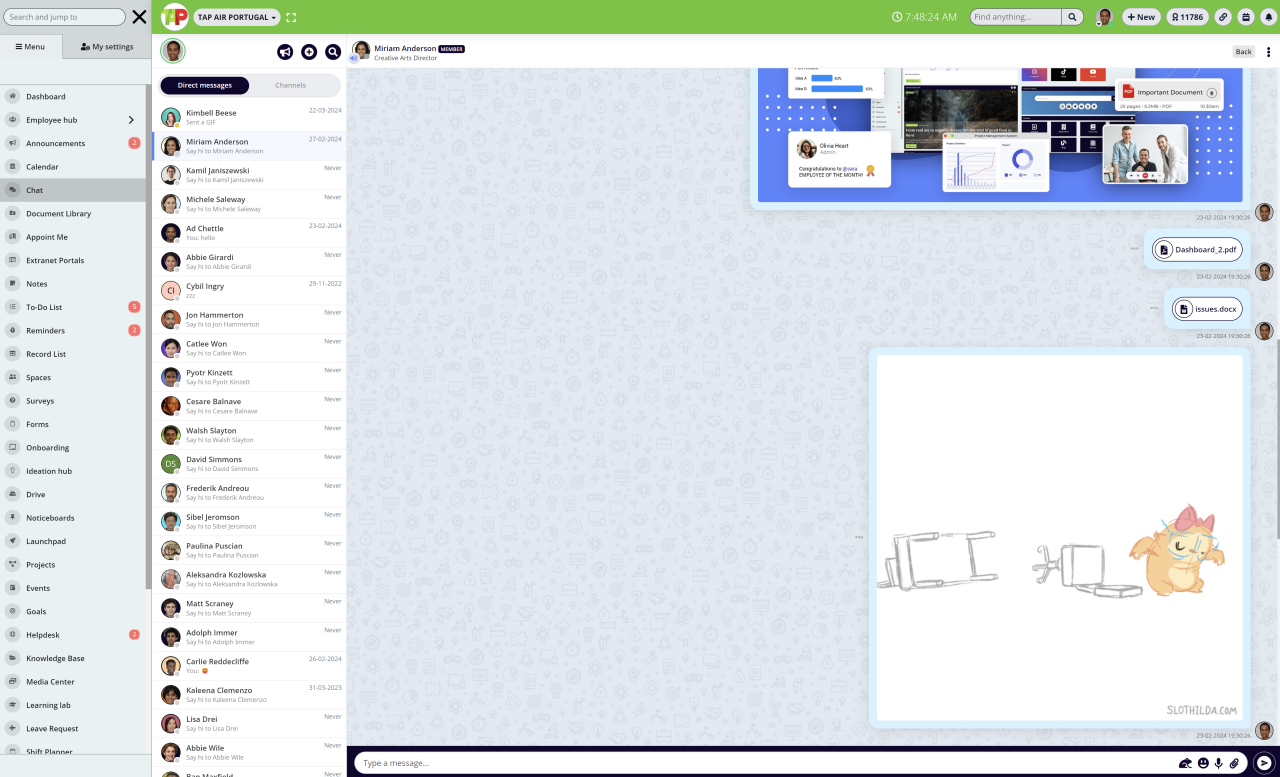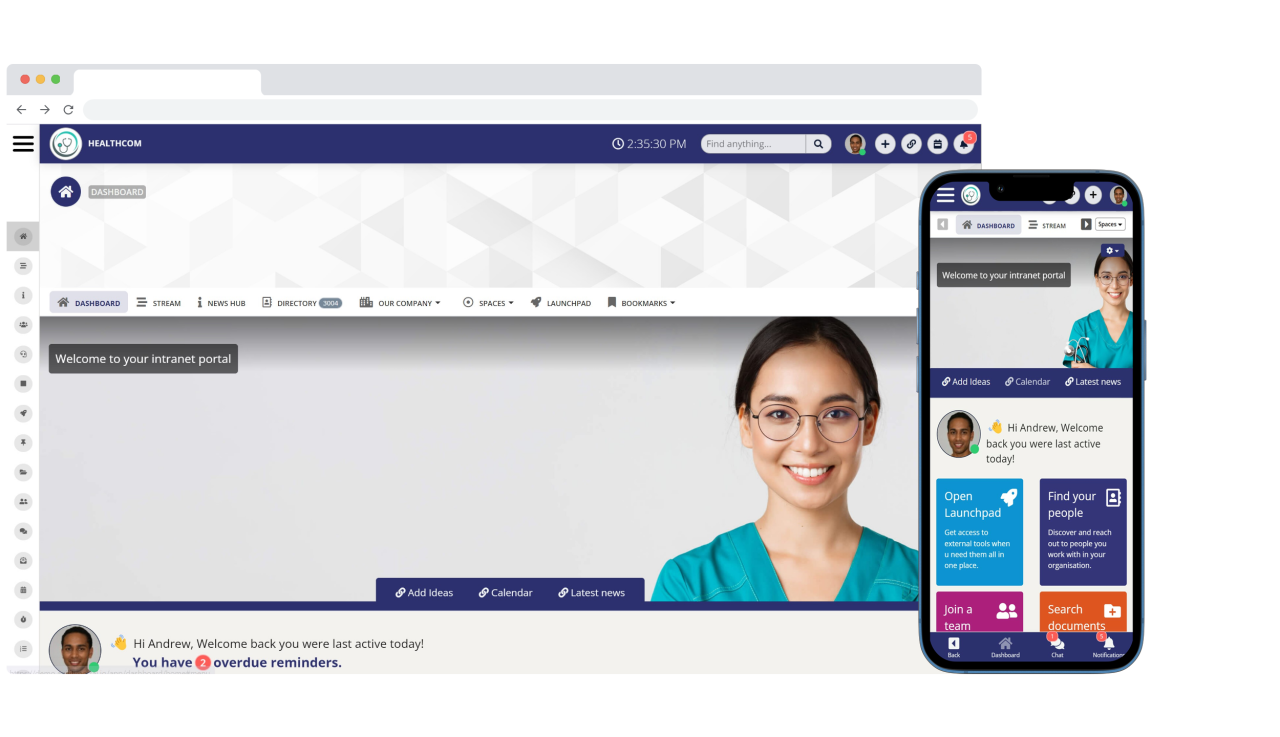Insight Blog
Agility’s perspectives on transforming the employee's experience throughout remote transformation using connected enterprise tools.
19 minutes reading time
(3775 words)
Real-time messaging: Unlock Seamless Communication in 2024
Learn how real-time messaging fosters seamless communication within your workplace. Unlock Seamless Communication in 2024.
In today's fast-paced digital landscape, customers demand instantaneous communication from businesses.
Gone are the days of enduring lengthy phone queues or waiting for email responses. Instead, consumers seek immediate resolutions to their inquiries and expect real-time messaging to deliver precisely that, thereby enhancing their overall experience with a brand.
While traditional communication channels like email and phone calls serve their purposes, they may not suffice when it comes to addressing customers' immediate needs or queries.
Real-time instant messaging fills this gap by providing businesses with a direct and instantaneous touchpoint to engage with their audience, ensuring prompt responses to questions, concerns, and feedback.
This article delves into the concept of real-time messaging, elucidating its significance in modern business practices and offering insights into its effective implementation to elevate customer experience.
What Is Real-Time Messaging?
Real-time instant messaging serves as a dynamic conduit for two-way text communication between customers and businesses, often referred to as conversational SMS.
Beyond mere correspondence, leveraging real-time messaging services can significantly bolster customer experience, fuel business growth, and amplify conversion rates.
The versatility of conversational text extends beyond conventional communication channels, offering a potent solution for addressing customer service backlogs, particularly during periods of heightened demand. Studies reveal that an overwhelming 83% of online consumers exhibit loyalty towards businesses capable of promptly resolving or acknowledging their concerns.
The impact of exemplary customer service transcends mere satisfaction, as evidenced by statistics indicating that a staggering 86% of initial purchasers receiving stellar support are inclined to become enthusiastic brand advocates.
So, an impressive 93% of these satisfied customers are likely to evolve into loyal repeat buyers.
Despite the evident benefits, maintaining round-the-clock human customer service support poses a logistical challenge for many businesses. Real-time messaging systems emerge as indispensable assets, offering an efficient and accessible means of maintaining customer engagement and satisfaction. One notable example is the WhatsApp Business API, which allows businesses to manage and scale their customer interactions more effectively.
Within the realm of business communication, several platforms have gained prominence for their real-time messaging capabilities:
- Enterprise Messaging Platforms: Solutions like AgilityPortal Messaging, Microsoft Teams, and Slack provide comprehensive frameworks tailored to the diverse communication needs of businesses, fostering seamless collaboration and information exchange.
- Free Instant Messaging Tools: Widely utilized platforms such as Instagram, Facebook Messenger, Viber, and WhatsApp offer businesses a cost-effective means of engaging with customers in real-time, leveraging familiar interfaces and expansive user bases.
- Website Live Chat Apps: Dedicated live chat applications like the Zendesk Support Suite, Zoho Desk, and LiveChat empower businesses to embed real-time communication functionalities directly into their websites, facilitating immediate assistance and support for visitors and customers alike.
Incorporating real-time messaging into business operations not only streamlines communication processes but also cultivates stronger customer relationships, laying the foundation for sustained growth and success in today's competitive landscape.
The Significance of Real-Time Messaging in Business
Real-time messaging has become an indispensable tool for businesses across various industries, revolutionizing communication and collaboration within organizations.
The immediacy and efficiency of real-time messaging platforms enable swift decision-making, seamless coordination, and enhanced productivity among teams.
According to recent statistics, businesses that adopt real-time messaging experience a significant reduction in response times, with up to 43% improvement in customer satisfaction rates.
This underscores the critical role real-time messaging plays in meeting the demands of today's fast-paced business environment.
Moreover, real-time messaging fosters better internal communication, breaking down silos and facilitating cross-functional collaboration. Teams can exchange ideas, share updates, and address issues instantaneously, regardless of geographical barriers.
Studies show that companies leveraging real-time messaging tools witness a 32% increase in employee engagement and a 25% boost in overall team performance. These statistics highlight how real-time messaging strengthens internal cohesion and empowers employees to work more efficiently towards common goals.
Real-time messaging through Whatsapp marketing software like WANotifier serves as a powerful customer engagement tool, enabling businesses to provide immediate support and personalized assistance to their clients. Research indicates that companies offering real-time messaging support witness a 48% increase in customer retention rates and a 40% rise in customer satisfaction levels.
By offering instant responses to inquiries and resolving issues in real-time, businesses can cultivate stronger customer relationships and differentiate themselves in a competitive marketplace.
In addition to enhancing operational efficiency and customer satisfaction, real-time messaging also contributes to data-driven decision-making and business agility. With features such as message analytics and real-time monitoring, organizations can gather valuable insights into communication patterns, customer preferences, and market trends.
This data-driven approach empowers businesses to adapt quickly to changing conditions, seize opportunities, and stay ahead of the curve.
Ultimately, the adoption of real-time messaging is not just a convenience but a strategic imperative for businesses looking to thrive in today's dynamic and interconnected world.
Modern vs. traditional real-time messaging
Modern real-time messaging platforms, exemplified by chat apps and instant messaging services, have revolutionized how we communicate, offering many features that enhance interaction and engagement.
These platforms provide users rich content capabilities, allowing them to seamlessly share text, images, videos, and audio recordings in real-time. Moreover, modern messaging platforms often boast extended character limits, enabling users to express themselves more comprehensively and fluidly than traditional methods like SMS.
Additionally, modern real-time messaging services leverage the internet for connectivity, eliminating the dependency on telecom networks and enabling communication globally with minimal barriers.
In contrast, traditional real-time messaging methods, such as phone calls and SMS, offer simplicity and immediacy but lack modern platforms' advanced features and flexibility. While phone calls provide direct and instantaneous communication, they are limited to audio interactions and can be intrusive or impractical in certain situations.
Similarly, SMS, while widely accessible and reliable, is constrained by its text-only format and limited character count.
However, these traditional methods still hold value in scenarios where simplicity and reliability are paramount, such as urgent communications or situations where internet connectivity may be limited.
| Feature | Tradition SMS | Chat Apps |
| Content |
Text only | Rich content (sounds, images, video) |
| Character Limit | 160 character limit | 640 character limit (Facebook) |
| Connectivity | Needs telco network | Needs internet |
Benefits of real-time messaging for business
Incorporating instant messaging (IM) into your internal communication strategy ensures smooth and efficient business operations.
When employees remain focused on work projects and avoid distractions while utilizing IM apps, the benefits for company growth are substantial.
- Communicating with customers and providing services or technical support.
- Send reminders to customers and team members regarding meetings or appointments.
- Collaborating on projects by sharing files and updates in real-time, which is particularly useful for dispersed teams.
- Conducting polls among team members or soliciting their ideas and opinions.
- Checking in with employees, including those who work away from desks, to inquire about their well-being and offer support in their tasks.
Here, we emphasize the advantages of integrating instant messaging into your internal communication strategy:
Helps to connect employees and keep them engaged
Instant messaging is crucial in connecting employees, especially in today's work environment, where 71% of employees are either fully remote or working part-time due to the pandemic.
It facilitates prompt conversations and enables quick information sharing without the need for drafting lengthy emails or engaging in time-consuming phone calls to get a rapid response to inquiries. Whether your team members are dispersed remotely or co-located, instant messaging fosters connectivity by providing real-time updates on essential information.
It is also worth noting that apart from enhancing connectivity, instant messaging cultivates a friendly environment among colleagues.
Conversations held on instant messaging platforms contribute to building connections between team members, thereby improving work relationships and elevating company morale.
Can help in speedy issue resolution
Instant messaging greatly aids in speedy issue resolution, offering quick responses to pressing concerns.
Especially during a crisis, swiftly addressing issues is paramount to ensuring uninterrupted business operations. With instant messaging, this becomes achievable.
Messages are received, addressed, and resolved rapidly through real-time communication services. Even a simple thumbs-up emoji can significantly expedite issue resolution.
According to a survey, 66 percent of participants highlighted the importance of promptly resolving simple questions.
This underscores the effectiveness of incorporating an instant internal communication app into your business operations, as it increases the likelihood of employees obtaining the answers they need promptly.
Enhances Business Efficiency
Instant messaging in the workplace is convenient, easy to use, and prompt, boosting productivity and increasing efficiency. Its instantaneous nature saves time, as communication happens in real time.
According to a study, 21 percent of workers using instant messages experienced a moderate or significant improvement in productivity.
The same survey found that 75 percent of participants noticed decreased call and email volume.
So, instant messaging facilitates prompt feedback from team members and immediate access to shared files, further enhancing productivity. It also helps reduce miscommunication opportunities, streamline workflows, and improve efficiency.
Follow us and access great exclusive content everyday: Follow us on Google News
How businesses can use real-time messaging
Utilizing real-time messaging for customer engagement opens up numerous opportunities for businesses. Any customer interaction that can be efficiently resolved without needing in-person communication benefits from this approach.
Below are several prevalent use cases that highlight the versatility of real-time messaging in enhancing customer engagement:
Customer suppport
Customer support teams often utilize real-time messaging to engage with customers in various ways.
One key aspect is providing immediate assistance and addressing queries promptly. Support agents can respond swiftly when a customer reaches out via real-time messaging platforms such as live chat or instant messaging, minimizing waiting times and enhancing the overall customer experience.
Moreover, real-time messaging enables personalized interactions. Support agents can tailor their responses based on each customer's specific needs and preferences. This personalization helps build rapport and foster a positive relationship between the customer and the support team.
It's important to understand that real-time messaging allows for proactive engagement. Support agents can initiate customer conversations to offer assistance, provide relevant information, or address potential issues before they escalate.
This proactive approach demonstrates attentiveness and can prevent dissatisfaction or frustration on the customer's part.
It is also worth noting that real-time messaging facilitates seamless communication across multiple channels. Customers can reach out via their preferred platform: a website chat widget, social media messaging, or a dedicated app. Support agents can then manage these conversations from a centralized interface, ensuring consistency and efficiency in their responses.
Overall, leveraging real-time messaging in customer support enables quicker resolution of inquiries, fosters personalized interactions, supports proactive engagement, and facilitates seamless communication across channels, ultimately enhancing the overall customer experience.
Healthcare
In certain instances, individuals may encounter queries related to their health that don't necessarily warrant scheduling a formal doctor's appointment. Though not emergencies, these situations can still benefit from timely responses from healthcare professionals.
Real-time messaging emerges as a practical solution for addressing such concerns promptly.
Consider a scenario where a patient wishes to inquire about the potential adverse effects of a new medication when taken alongside their current prescriptions.
They can contact a registered nurse or another healthcare provider by leveraging real-time messaging for insights and advice. Moreover, platforms supporting various media formats enable patients to transmit photos or videos, facilitating more transparent communication and accurate assessments.
It's crucial to emphasize that while real-time messaging offers convenience, adherence to HIPAA guidelines is paramount. Patient privacy and confidentiality is essential when discussing healthcare matters through digital platforms.
Therefore, healthcare providers must adopt secure messaging systems that comply with HIPAA regulations to safeguard patient information effectively.
Real estate
Communication between customers and agents is integral in real estate, often involving numerous exchanges.
Particularly for clients in the initial stages of property research, real-time messaging proves invaluable in reducing prolonged wait times and promptly furnishing potential buyers or renters with essential information.
Consider a scenario where a prospective buyer wishes to schedule a property tour. Instead of resorting to traditional email communication, which might entail hours or days of waiting for a response, clients can utilize real-time messaging platforms to secure an appointment swiftly. This expedites the process significantly, enhancing customer satisfaction and engagement.
Also, integrating chatbots into real-time messaging systems streamlines routine interactions, such as appointment bookings, without necessitating immediate human intervention.
However, a hybrid approach combining automated chatbots and live agents proves most effective in addressing more intricate queries and ensuring seamless assistance.
This way, clients can receive prompt responses to straightforward inquiries while having access to live assistance for more complex questions or concerns, ultimately facilitating informed decision-making and expediting the transaction process.
Sales
In today's digital landscape, finding real-time messaging functionalities seamlessly integrated into websites offering products and services has become commonplace.
The recognition of real-time messaging drives this trend as a straightforward and highly effective means of engaging with potential customers who have already demonstrated interest in your business.
Gone are the days of requiring customers to navigate through convoluted processes and divulge copious personal information before accessing basic information about your offerings.
Real-time messaging empowers sales representatives to swiftly address visitors' inquiries and guide them toward the most suitable product or service, fostering a smoother and more personalized user experience.
The beauty of real-time messaging lies in its ability to facilitate direct communication with potential customers precisely when they are at the critical juncture of deciding whether to engage with your business. This timely interaction can significantly influence the outcome, potentially tipping the scales in favor of closing the deal.
A case study conducted by Neil Patel showcased a remarkable 45% improvement in conversion rates for a client, attributable to the implementation of live chat support.
While it's uncommon for customers to purchase directly within the chat interface due to potential user experience limitations, real-time messaging is a pivotal tool in furnishing them with all the necessary information and support to confidently proceed with their purchase decision.
Real-time messaging emerges as a valuable asset in enhancing customer engagement and driving sales growth by bridging the gap between inquiries and conversions.
Here are 3 popular instant messaging platforms widely used for business communication
Here are 3 instant messaging examples that highlight the diverse functionalities and benefits these platforms offer in the realm of modern business communication and collaboration.
Each platform—AgilityPortal, Slack, and Microsoft Teams—brings its unique set of features tailored to meet the needs of various business environments.
From real-time messaging and file sharing to integrated video conferencing and extensive integrations with third-party apps, these platforms empower teams to communicate effectively, collaborate seamlessly, and stay connected regardless of their physical location.
With businesses increasingly adopting remote work arrangements, instant messaging apps have become indispensable tools for enhancing productivity, fostering teamwork, and driving organizational success in today's digital age.
#1.Slack
With approximately 10 million daily users, Slack is a widely used messaging app. It allows users to create private channels, facilitating streamlined internal business communications and collaboration with external partners.
Recent estimates indicate that 32% of employees consider Slack one of the most effective tools for enhancing productivity.
- Private Channels: Users can create private channels to restrict access to specific team members, facilitating confidential discussions and project collaboration away from the general workspace.
- File Sharing: Slack allows users to share files of various formats directly within the platform, making it convenient for team members to access and collaborate on documents, images, and other media.
- Integrations: Slack offers a wide range of integrations with other productivity tools and services, allowing users to connect their favorite apps and streamline workflows without leaving the Slack interface.
- Search Functionality: With powerful search capabilities, Slack enables users to quickly find past messages, files, and conversations, ensuring easy retrieval of important information and reducing time spent searching for content.
- Customizable Notifications: Users can customize notification settings for channels and direct messages, ensuring they stay informed about important updates while minimizing distractions during focused work periods.
You may also like: Best Apps for Employees: UPDATED 2022 – A Complete Guide
#2.Microsoft Teams
Microsoft Teams stands out as the premier messaging app within the business realm, boasting an impressive user base of around 13 million daily users.
Its seamless integration with Microsoft 365 eliminates the need to switch between multiple platforms, enabling users to efficiently complete their work tasks within a unified software environment.
- Collaboration Hub: Microsoft Teams serves as a centralized hub for teamwork, offering channels to organize conversations, files, and tools related to specific projects or departments. This fosters collaboration and enhances communication among team members.
- Video Conferencing: Teams provides robust video conferencing capabilities, allowing users to host virtual meetings with up to 10,000 participants, share screens, and collaborate in real-time regardless of location.
- Integration with Microsoft 365: Seamlessly integrated with the Microsoft 365 suite, Teams enables users to access and edit documents, spreadsheets, and presentations within the app, streamlining workflow and enhancing productivity.
- Chat and Messaging: Teams offers instant messaging and chat features, allowing users to communicate one-on-one or in groups, share files, and collaborate on tasks in real-time. Threaded conversations help keep discussions organized and easily accessible.
- Customizable Tabs and Apps: Users can customize their Teams experience by adding tabs and integrating third-party apps directly into their channels. This allows for tailored workflows, access to important tools, and enhanced productivity within the Teams environment.
#3.AgilityPortal
This instant messaging application seamlessly integrates with the acclaimed cloud intranet software, providing users with a comprehensive collaboration experience.
Incorporating AgilityPortal Collaborate instant messaging not only enhances communication but also introduces valuable business chat features alongside existing collaboration tools like video conferencing and instant messenger.
With this integration, teams can streamline their workflows, foster efficient communication, and boost productivity across the organization.
- Seamless Integration: AgilityPortal Collaborate instant messaging seamlessly integrates with the cloud intranet software, providing users with a unified platform for communication and collaboration.
- Business Chat Features: The instant messaging app offers a range of business chat features, including one-on-one messaging, group chats, and channels, enabling efficient communication among team members.
- Video Conferencing: Users can leverage video conferencing capabilities within AgilityPortal Collaborate, facilitating virtual meetings, presentations, and discussions with colleagues, clients, or partners.
- Collaboration Tools: In addition to instant messaging and video conferencing, AgilityPortal Collaborate provides access to collaboration tools such as file sharing, document collaboration, and task management, enhancing teamwork and productivity.
- Customization Options: The platform offers customization options, allowing users to personalize their messaging experience by setting up custom notifications, creating custom chat groups, and organizing channels according to project or team requirements.
| Feature | AgilityPortal |
Slack | Microsoft Teams |
| Messaging |
Real-time messaging, group chats, direct messaging |
Real-time messaging, channels, direct messaging |
Real-time messaging, channels, direct messaging |
| File Sharing | Yes | Yes | Yes |
| Video Conferencing | Integrated video calls, screen sharing | Integrated video calls, screen sharing | Integrated video calls, screen sharing |
| Integrations | Limited | Extensive integrations with third-party apps | Integrations with Microsoft Office apps, third-party apps |
| Customization | Limited | Highly customizable | Customizable with Microsoft 365 integration |
| Cost | Starts at $3/user/month for basic features | Starts at $6.67/user/month for standard plan | Included in Microsoft 365 subscription |
| Use Case | Small to medium-sized teams needing basic collaboration tools | Small to large teams needing extensive integrations and customization | Medium to large organizations leveraging Microsoft 365 suite |
The Crucial Role of Instant Messaging Apps Play in Facilitating Communication and Collaboration within Businesses
Instant messaging apps play a crucial role in facilitating communication and collaboration within businesses, especially in environments with remote workers.
Here are some insightful analyses regarding their impact:
- Enhanced Collaboration: Instant messaging apps break down communication barriers and enable real-time collaboration among remote workers. With features like group chats, direct messaging, and file sharing, team members can quickly exchange ideas, share updates, and collaborate on projects irrespective of their physical location.
- Increased Productivity: By providing a platform for instant communication, these apps can significantly boost productivity. Remote workers can quickly ask questions, seek clarification, or provide updates without the delays associated with traditional communication methods like email or phone calls. This immediacy fosters a more dynamic and responsive work environment.
- Improved Team Dynamics: Instant messaging apps contribute to building stronger team dynamics among remote workers. Features such as emojis, GIFs, and reaction buttons add a layer of personalization to conversations, making interactions more engaging and fostering a sense of camaraderie among team members who may be geographically dispersed.
- Efficient Information Sharing: With the ability to share files, documents, and even screens in real-time, instant messaging apps facilitate efficient information sharing. Remote workers can collaborate on documents simultaneously, provide feedback on presentations, or troubleshoot issues by sharing screens, leading to faster problem-solving and decision-making processes.
- Integration Capabilities: Many instant messaging apps offer integration with other business tools and applications, such as project management software, CRM systems, or file storage platforms. This integration streamlines workflows and centralizes communication, allowing remote workers to access all necessary information and tools within a single platform, thereby reducing context switching and improving overall efficiency.
- Maintaining Connectivity: For remote workers, instant messaging apps serve as a lifeline to the broader organization. Beyond work-related discussions, these platforms also facilitate casual conversations and social interactions, helping remote workers feel connected to their colleagues and the company culture despite physical distance.
- Security and Compliance: With the rise of remote work, ensuring the security and compliance of communication platforms has become paramount. Businesses need to carefully evaluate the security features offered by instant messaging apps, such as end-to-end encryption, data retention policies, and compliance with industry regulations, to protect sensitive information and mitigate potential risks.
In a nutshell, instant messaging apps play a vital role in empowering businesses with remote workers by facilitating seamless communication, enhancing collaboration, and fostering a sense of connectivity and belonging among team members, ultimately contributing to improved productivity and organizational success.
Ready to incorporate messaging apps into your communication strategy? Experience the benefits with AgilityPortal today.
Instant messaging significantly enhances a company's internal communications, making them more accessible and efficient. Its positive impact often translates into a more successful business overall.
If your business still needs to adopt instant messaging, consider contacting AgilityPortal today. With real-time messaging, your business operations can become smoother and your employees more connected.
Our expert advisers can help you find the best instant messaging apps tailored to your business needs. Contact us today for a straightforward conversation about instant messaging and communication systems.
Free ebook: How To Get Your Intranet Off The Ground
Categories
Blog
(2604)
Business Management
(320)
Employee Engagement
(208)
Digital Transformation
(173)
Intranets
(119)
Growth
(118)
Remote Work
(61)
Sales
(48)
Collaboration
(37)
Culture
(29)
Project management
(29)
Customer Experience
(26)
Knowledge Management
(21)
Leadership
(20)
Comparisons
(5)
News
(0)
Ready to learn more? 👍
One platform to optimize, manage and track all of your teams. Your new digital workplace is a click away. 🚀
Free for 14 days, no credit card required.

















